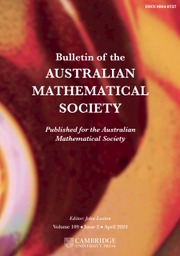No CrossRef data available.
Article contents
Decomposition of the Steinberg group over local rings into involutions
Published online by Cambridge University Press: 17 April 2009
Abstract
Core share and HTML view are not available for this content. However, as you have access to this content, a full PDF is available via the ‘Save PDF’ action button.
We consider the stable Steinberg group St (R) over local rings. An element x is called an involution if x2 = 1. We prove that every element δ in St (R) is the product of at most 5 involutions.
- Type
- Research Article
- Information
- Bulletin of the Australian Mathematical Society , Volume 61 , Issue 1 , February 2000 , pp. 97 - 107
- Copyright
- Copyright © Australian Mathematical Society 2000
References
REFERENCES
[1]Ambrosiewicz, E., ‘Powers of set of involutions in linear group’, Demonstratio. Math 24 (1991), 311–314.Google Scholar
[2]Dennis, R.K. and Vaserstein, L.N., ‘On a question of M. Newman on the number of commutators’, J. Algebra 118 (1988), 150–161.Google Scholar
[3]Gustafson, W.H., ‘On products of involutions’, in Paul Halmos celebrating 50 years of Mathematics (Springer-Verlag, Berlin, Heidelberg, New York, 1991).Google Scholar
[4]Gustafson, W.H., Halmos, P.R. and Radjavi, H., ‘Products of involutions’, Linear Algebra Appl. 13 (1976), 157–162.Google Scholar
[5]Hahn, A. and O'Meara, O.T., The classical groups and K-theory (Springer-Verlang, Berlin, Heidelberg, New York, 1989).Google Scholar
[6]Knuppel, F. and Nielsen, K., ‘SL (V) is 4-involutional’, Geom. Dedicata 38 (1991), 301–308.CrossRefGoogle Scholar
[7]Milnor, J., Introduction to algebraic K-theory (Princeton University Press, Princeton, 1971).Google Scholar
[8]Silvester, J.R., Introduction to algebraic K-theory (Chapman and Hall, London, New York, 1981).Google Scholar
[9]You, H. and Nan, J.Z., ‘Decomposition of matrices into 2-involutions’, Linear Algebra Appl. 186 (1993), 235–243.Google Scholar


